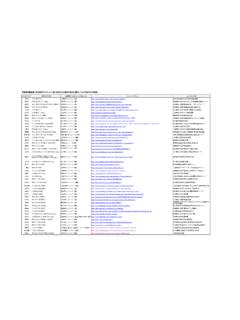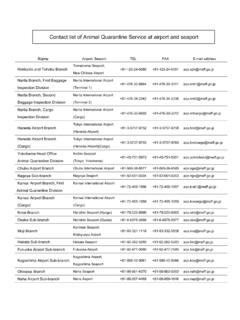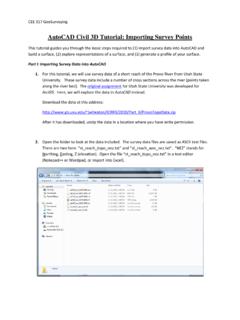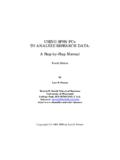Transcription of Guide to importing dogs and cats into Japan from …
1 Guide to importing dogs and cats (from the designated regions) 1 This Guide describes the requirements and necessary procedures for importing dogs and cats into Japan from the designated regions. We strongly recommend reading this Guide if you are planning to bring dogs or cats into Japan . For further information, feel free to contact Animal Quarantine Service. Appended Form 5-1 Guide to importing dogs and cats into Japan from the designated regions (Final revision: April, 2017) Animal Quarantine Service Ministry of Agriculture, Forestry and Fisheries What are the designated regions ? Iceland, Australia, New Zealand, Fiji Islands, Hawaii and Guam. *The designation is subject to change due to the prevalence of rabies or the revision of quarantine regulations. Guide to importing dogs and cats (from the designated regions) 2 A. Introduction.
2 3 Importer s responsibility .. 3 Animals covered by this Guide .. 3 B. Import quarantine 4 Flow chart .. 4 STEP 1: Microchip .. 5 STEP 2: Regulations on residence .. 6 STEP 3: Advance notification .. 7 1. Submission of notification .. 7 2. Approval of Import Inspection of Animals .. 8 3. Modification of Notification .. 8 STEP 4: Clinical inspection before departure (pre-export inspection) .. 9 STEP 5: Obtaining certificates issued by the government agency of the exporting country 10 1. Required information in the certificates .. 10 2. Advance confirmation of the certificates .. 11 STEP 6: Regulations on transportation .. 12 STEP 7: Import inspection after arrival in Japan .. 13 1. Inspection upon arrival .. 13 2. Quarantine inspection at a detention facility of Animal Quarantine Service .. 15 [Reference 1] Notes for transportation .. 17 1. Ports of entry where import is allowed.
3 17 2. Health condition for transport .. 17 3. Transport cage .. 18 4. Types of transportation .. 18 [Reference 2] Recommended treatments (vaccinations, parasite treatment) .. 19 1. Vaccinations (combination vaccine) .. 19 2. Treatment for external and internal parasites .. 19 C. List of Animal Quarantine Service .. 20 D. Management after import into Japan .. 21 Contents Guide to importing dogs and cats (from the designated regions) 3 Inspections and treatments in the exporting country Advance notification Obtaining all necessary documents including certificates Arrangements for transportation Application for Import Inspection upon arrival in Japan Measures and expenses for quarantine at a detention facility, if necessary Reshipment or euthanasia if import is not permitted Other matters that an animal quarantine officer may instruct as necessary Dogs and cats imported into Japan must undergo import quarantine in accordance with the Rabies Prevention Law and, additionally for dogs, the Domestic Animal Infectious Diseases Control Law.
4 For dogs and cats meeting certain requirements upon arrival in Japan , the quarantine period (for import inspection) will be within 12 hours. Any dogs and cats that do not meet the requirements will be subject to quarantine at a detention facility of Animal Quarantine Service for the necessary period (up to 180 days). Depending on the results of the import inspection, the dog or cat cannot be allowed to enter Japan . The importer (person planning to import dogs or cats) is responsible for the following obligations at their own expense. You should begin the importation procedure only after fully understanding and accepting these obligations. This Guide applies to the following animals and first-generation hybrids*1 between these and other animals. Type of Animal Family Genus Species Scientific name* Dog Canidae Canis Domestic dog Canis familiaris Cat Felidae Felis Domestic cat Felis catus *1 First-generation hybrid: a cross between distinctly different parental types.
5 Examples: Wolfdog (domestic dog wolf); Savannah cat (domestic cat serval) *2 Source: A World List of Mammals with Japanese Names (Heibonsha Limited, 1998) A. Introduction Importer s responsibility Animals covered by this Guide Guide to importing dogs and cats (from the designated regions) 4 . B. Import quarantine procedures Flow chart Regulations on residence Microchip (identification) Regulations on transportation Advance Notification Pre-export inspection Obtaining certificates Import inspection Arrival STEP 7 Has been continuously resident only in the designated regions *not less than 40 days before arrival.. STEP 1 . STEP 2 . STEP 3 . STEP 4 . STEP 5 . STEP 6 Since birth or 180 days or more or Since being directly imported from Japan Guide to importing dogs and cats (from the designated regions) 5 Timing of microchip implanting Recommended microchip standards *What is a microchip?
6 This is a small chip that contains a unique identification number. An inserter shaped like an injection syringe is used to implant the microchip under the skin. The number is read by a specially designed scanner, enabling identification of the dog or cat. All dogs and cats imported into Japan must be identified by a microchip. The microchip must be implanted before Advance Notification [ STEP 3]. ISO 11784 and 11785 (15-digit microchip code which consists only of numbers.) (ISO: International Organization for Standardization) Microchip can be implanted at a veterinary hospital. Make sure that the microchip number can be read by a microchip reader upon each inspection and treatment at a veterinary hospital. If the microchip number cannot be read or the microchip number does not match the number on the certificates issued by the government agency of the exporting country [ STEP 5] at the import inspection [ STEP 7], the dog or cat will be subject to 180-day quarantine [ STEP 7-2] or be returned or euthanized at the importer s own expense.
7 If the microchip is not in accordance with ISO standards, or if a method other than microchip is used for identification, you should contact Animal Quarantine Service at the expected port of entry [ p. 20]. STEP 1: Microchip Precautions Guide to importing dogs and cats (from the designated regions) 6 At least one of the following regulations on residence shall be fulfilled. Dogs and cats imported from the designated regions must fulfill at least one of the following three conditions: 1. The dog or cat has been continuously resident in a designated region since birth. 2. The dog or cat has been continuously resident in a designated region for at least 180 days immediately before export to Japan . 3. The dog or cat has been continuously resident in a designated region since being directly imported from Japan . If none of the above three conditions is fulfilled and the dog or cat has been continuously resident in a designated region for less than 180 days, the dog or cat must be subject to quarantine inspection at a detention facility of Animal Quarantine Service [ STEP 7-2] upon arrival in Japan to compensate for the insufficient days (180 days minus the days when the dog or cat was kept in a designated region).
8 STEP 2: Regulations on residence Regulations on residence If none of the above three conditions is fulfilled Guide to importing dogs and cats (from the designated regions) 7 1. Submission of notification The importer must notify Animal Quarantine Service at the expected port of entry not less than 40 days before arrival in Japan . The importer must submit a Notification to Animal Quarantine Service at the expected port of entry [ p. 20] by mail, fax or e-mail not less than 40 days before arrival in Japan . Notification form is available on the website of Animal Quarantine Service. For dogs: Notification for Import of Dogs under the Rabies Prevention Law and the Domestic Animal Infectious Diseases Control Law For cats: Notification of Import of Animals under the Rabies Prevention Law Hints for Notification " Date of birth (Age): If the date of birth is unknown, enter the age of the dog or cat at the time of arrival Scheduled place of arrival: Name of the expected arrival airport or seaport Consignor: The person exporting or traveling with the dog or cat from abroad Consignee: The person receiving the dog or cat upon arrival in Japan Date of identification: The date that the microchip was implanted Cargo or hand luggage: The type of transportation [ Reference 2-4] Name and address of destination: Place where the dog or cat will be kept after import into Japan Rabies vaccination.
9 Information on rabies vaccinations administered Date of expiry: Not the expiration date for use of the vaccine, but the duration of immunity (effective period) Kind of vaccine: Rabies vaccination inactivated (killed) virus vaccine or recombinant vaccine Other vaccination names of target diseases (such as distemper, feline calicivirus, etc.) Date of blood sampling: The date that the blood sample was taken for the rabies antibody test Ports of entry for importing dogs are restricted. [ Reference 1-1] Clearly indicate the contact information on the Notification. In principle, a notification submitted less than 40 days before arrival in Japan will not be accepted. If the port of entry has not been determined 40 days before arrival in Japan , you can submit the Notification filled out with provisional information to one of Animal Quarantine Service at the most likely port of entry.
10 After the plans are finalized, submit a Modification on Notification of Import of Animals [ STEP 3-3]. STEP 3: Advance notification Notification can be made online through the NACCS (Nippon Automated Cargo and Port Consolidated System). Precautions Guide to importing dogs and cats (from the designated regions) 8 If the original notification was made online through the NACCS, modification must be made through the NACCS, too. *Before making any changes, you need to contact Animal Quarantine Service to which the "Notification" was submitted. Animal Quarantine Service issues an Approval of Import Inspection of Animals to the applicant after receiving the Notification and confirming its contents. The Approval of Import Inspection of Animals is necessary for the import inspection [ STEP 7]. In addition, it may be necessary to present this document during procedures in the exporting country or boarding procedures by the airlines or shipping lines.

















